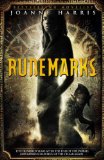Summary | Excerpt | Reading Guide | Reviews | Beyond the Book | Read-Alikes | Genres & Themes | Author Bio

Critics' Opinion:
Readers' Opinion:
First Published:
Jan 2008, 544 pages
Paperback:
Oct 2009, 544 pages
 Book Reviewed by:
Book Reviewed by:
BookBrowse Review Team
Buy This Book
This article relates to Runemarks
Norse mythology is the best preserved version of Germanic paganism,
sharing the same essential pantheon with Anglo-Saxon mythology. Both have
their roots in a hypothetical Indo-European mythology that is believed to be at
the root of most pre-Christian religions in Europe and India (including
Hinduism, Jainism and Zoroastrianism) because they all share significant
commonalities. For example, Zeus, Jupiter, Thor and Indra are all thunder-gods
and all are associated with the same day of the week - Thursday: English derives
Thursday from Thor, while the French Jeudi and Italian Goivedi
come from the Latin Jovis (or Iovis) Dies meaning Jupiter
Day.
Norse mythology is a collection of beliefs, not a set doctrine. Originally orally
transmitted, most of our knowledge of it comes from a few medieval texts
including the Elder Edda (Poetic Edda), and Younger
Edda (Prose Edda), which were written down between 1000 and 1300 AD.
The Norse believed there were nine worlds, most of which play a part in
Runemarks
Runes - Pragmatic or Divine?
Runes were the alphabetic script of the people of Northern Europe.
Although there is debate of the origins, it is believed that they derived from
Roman letters. In addition to their use as a written alphabet, runes also served
as symbols used for magic and divination and are actual words in the language; for example fehu (F) can mean cattle or wealth (one being synonymous with the other). Thus, the rune Fehu indicates possessions won or earned, good luck, sign of hope and plenty, success and happiness. Whereas Fehu Reversed indicates loss of personal property or esteem, or some sort of failure; cowardice, stupidity and so forth.
Runes remained in common use well into the
17th century, until they were officially banned by the church in 1639.
Norse mythology says that the runes originated from the god Odin and came to man
through the god Heimdall, the guardian of the gods and the link between Midgard
and Asgard. Heimdall sired three sons with human women: Thrall, Churl and Jarl.
When Jarl was old enough to show signs of his nobility, Heimdall claimed him as
his son and taught him the runes. Thus Thrall, Churl and Jarl were the ancestors
of the three classes of men: slave, freeman and noble.
A less divine interpretation is offered by the Eastern Roman historian Procopius
(500-565 AD) who records that after raiding the European continent for a few
generations, the Germanic people known as the heruli, retreated back to
Scandinavia in 512 AD. As their old territory was now occupied by the Danes they
settled in present-day Sweden. The Proto-Norse word for the heruli is erilar,
etymologically close to jarl (the modern-day Norwegian word for Earl). So it
doesn't seem too far fetched to extrapolate that the heruli might have brought
back the runic alphabet with them and leveraged their knowledge of the runes
into a magical art, thus placing themselves firmly at the top of the local
hierarchy; and, like many a culture before and after them, then consolidated
their position with the help of a few well placed myths!
Filed under Cultural Curiosities
![]() This "beyond the book article" relates to Runemarks. It originally ran in February 2008 and has been updated for the
October 2009 paperback edition.
Go to magazine.
This "beyond the book article" relates to Runemarks. It originally ran in February 2008 and has been updated for the
October 2009 paperback edition.
Go to magazine.





The Flower Sisters
by Michelle Collins Anderson
From the new Fannie Flagg of the Ozarks, a richly-woven story of family, forgiveness, and reinvention.

The House on Biscayne Bay
by Chanel Cleeton
As death stalks a gothic mansion in Miami, the lives of two women intertwine as the past and present collide.

The Funeral Cryer by Wenyan Lu
Debut novelist Wenyan Lu brings us this witty yet profound story about one woman's midlife reawakening in contemporary rural China.
Your guide toexceptional books
BookBrowse seeks out and recommends the best in contemporary fiction and nonfiction—books that not only engage and entertain but also deepen our understanding of ourselves and the world around us.